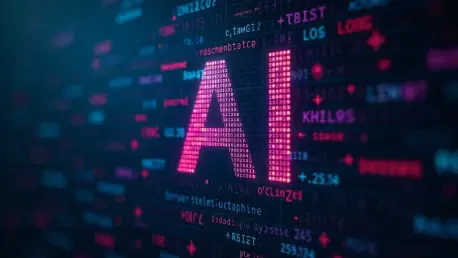In an era where artificial intelligence is reshaping industries, there is a burgeoning demand for tools that simplify this integration, particularly those that democratize access for users with limited technical expertise. No-code computer vision technology has emerged as a solution, offering platforms that allow effortless creation and deployment of AI models that interpret visual data. This technology, marked by rapid advancements, holds profound relevance in today’s technological landscape, as businesses seek innovative means to optimize processes and enhance productivity without the barrier of coding expertise.
Simplified Model Creation and Deployment
No-code computer vision platforms are revolutionizing artificial intelligence model creation by providing intuitive interfaces for users. These tools enable individuals to build sophisticated AI models, accelerating the development process while removing complexities linked to traditional programming. Performance improvements are notable—models are crafted significantly quicker, and this accessibility is especially invaluable for non-technical users aiming to leverage AI without the need to understand complex coding paradigms.
The significance of these platforms extends beyond mere ease, prompting widespread adoption across various industries. The ability to deploy models with seamless workflows is transformative, as it bridges gaps between technological prowess and practical application. Through these tools, businesses can harness AI capabilities confidently, fostering innovation in operations and idea realization.
Automated Dataset Labeling
Integral to the success of no-code computer vision technology is the automation of dataset labeling. This aspect of data preparation is pivotal, as accurately labeling data ensures AI models’ effectiveness in real-world applications. Automated tools streamline this laborious process, significantly reducing time requirements while enhancing accuracy rates. Such advancements are critical, particularly for industries where extensive data sets are demanding and complex.
Moreover, automated dataset labeling resonates well beyond technical applications, presenting tangible real-world benefits. Businesses have gravitated toward these tools for their operational efficiency and reliability, recognizing the advantages of automated processes and faster data insights. The technology continues to redefine how data is prepared and utilized, offering new opportunities to explore and apply AI in innovative ways.
Innovations and Trends
Recent years have seen noteworthy developments in no-code computer vision technology, driven by industry demands for smarter and more adaptable solutions. New innovations, such as enhanced deployment capabilities and expanded model repositories, cater to varied consumer needs while fueling accelerated technological progress. The industry’s trajectory is influenced by evolving consumer behavior and industrial needs, both of which necessitate efficient and scalable AI solutions.
Furthermore, significant shifts in market dynamics have shaped the path forward for no-code computer vision. Businesses prioritize agility and ease of deployment, pushing developers to innovate continuously, crafting solutions with enhanced versatility. This ongoing evolution underscores a larger trend toward accessible technology, tailored to meet users’ growing demands and expectations.
Real-World Applications and Implementations
No-code computer vision technology holds immense utility across a variety of sectors, offering transformative applications. In manufacturing, AI is utilized to inspect products at speeds unattainable by human effort, identifying faults quickly and precisely. Similarly, healthcare has embraced AI for the analysis of medical imaging, aiding diagnosis and treatment planning with enhanced accuracy and efficiency.
Retail sectors leverage computer vision for virtual try-ons, elevating customer experiences and operational strategies. Automotive industries, notably autonomous vehicles, rely heavily on these models to navigate environments safely, showcasing the technology’s capabilities in revolutionizing modern transportation. Each application highlights AI’s expanding utility, demonstrating how industries can integrate AI seamlessly to bolster innovation and efficiency.
Challenges and Limitations
Despite its promising attributes, no-code computer vision technology faces several challenges. Technical hurdles abound, including model accuracy and dataset limitations that must be addressed for wide-scale adoption. Regulatory challenges pose another barrier, with evolving compliance requirements necessitating careful navigation in implementation strategies.
Efforts to overcome these challenges are underway, with industry leaders focusing on advancing technology to facilitate broader adoption. Innovative measures aim to expand data set offerings, improve model accuracy, and tackle regulatory constraints head-on. These endeavors promise a future where AI technologies can be more universally applied, unlocking the full potential of no-code computer vision platforms.
Future Outlook for No-Code Computer Vision
The horizon for no-code computer vision technology is ripe with potential breakthroughs. Anticipated developments include enhanced ease of use, expanded industry applications, and refined AI models offering unprecedented precision and efficiency. The impact on industries will be substantial, fostering new ways to interact with technology and integrate AI into everyday processes seamlessly.
Beyond industry-specific implications, societal change is an inevitable outcome. As technology permeates various arenas, its capabilities to transform lives and workplaces will be profound. The future of no-code computer vision is poised to showcase increasingly sophisticated applications, further driving innovation and enhancing collaborative endeavors across sectors.
Conclusion and Assessment
Reflecting on no-code computer vision technology’s trajectory, it demonstrates remarkable progress in democratizing AI capabilities. Key features such as simplified model creation and automated dataset labeling have redefined AI integration processes, presenting accessible solutions for technical and non-technical users alike. While challenges persist, technological advancements and strategic collaborations pave the way for overcoming hurdles, suggesting sustained growth and innovation in applications.
Assessing the current state, potential advancements, and future implications, no-code computer vision remains a pivotal element in the technological landscape, offering powerful yet accessible AI solutions to individuals and industries aiming to capitalize on visual data insights. The potential for widespread adoption and transformative impact is significant, setting the stage for further evolution and long-term advancements across multiple fields.









